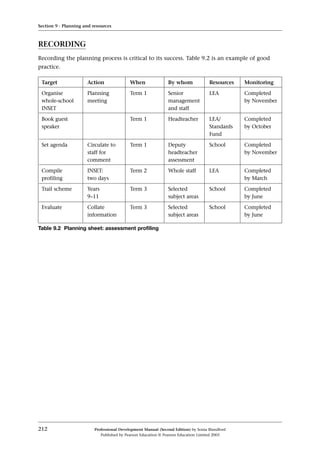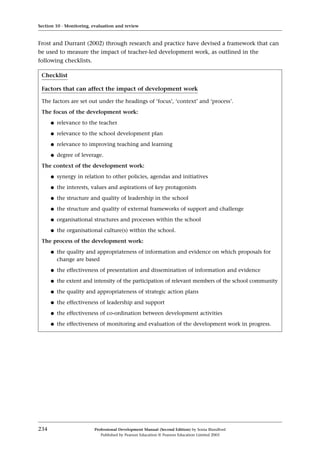This document provides a summary of 10 professional development manuals focused on various aspects of school management, leadership, and staff development. The manuals cover topics such as developing and managing effective school teams, public relations and marketing for schools, school improvement, self-evaluation processes, governance, recruitment and selection, management roles, curriculum management, and using student assessment data.
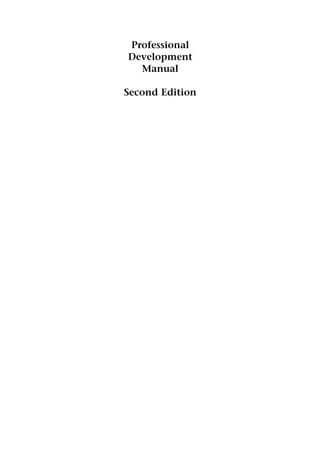





















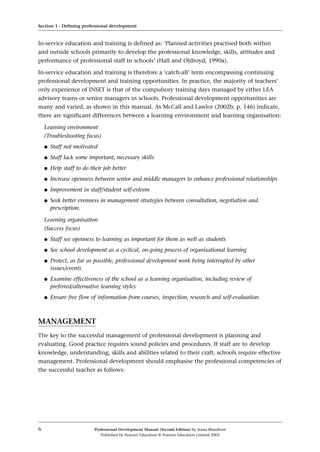

![Estelle Morris, Secretary for State for Education and Skills (DfES, 2002), stated:
It’s [CPD] actually core to the standards agenda. It’s actually the essence of what we mean by
improving the station of the profession, by giving teachers more standing in the community and
amongst other professions, and without professional development we can’t possibly get what we
all want to achieve, which is better teaching and more effective learning in the classroom, so in
terms of where its place is in the big picture, in the big education strategy, it’s core to everything
that’s been done and it’s core to everything that’s going to go on in the future.
The need for professional development is rooted in the changing role of education
practitioners. The culture of schools is also changing. Rapid changes to the curriculum and
the devolution of management responsibilities from LEAs to schools have led to a shift in
management and leadership styles affecting schools as organisations, as follows:
Teachers are involved in:
q day-to-day management of teaching, learning and resources; collaboration on clearly
defined tasks, monitoring and evaluation
q participation by representation in working groups set up by the senior management team
to discuss specific tasks or directives from governing agencies or school policy groups.
Teacher life long learning in the form of continuing professional development (CPD) is
increasingly regarded as an important means of contributing to the creation of more effective
schools, and as integral to learning organisations.
Source: O’Brien and MacBeath (1999)
8 Professional Development Manual (Second Edition) by Sonia Blandford
Published by Pearson Education © Pearson Education Limited 2003
Chapter 2
WHY PROFESSIONAL
DEVELOPMENT?
From: To:
fixed roles flexible roles
individual responsibility shared responsibility
autocratic collaborative
control release
power empowerment](https://image.slidesharecdn.com/34b749fb-5f3f-46c3-b666-27e993ce3bd1-150203125634-conversion-gate02/85/Professional-Development-Manual-25-320.jpg)

























































































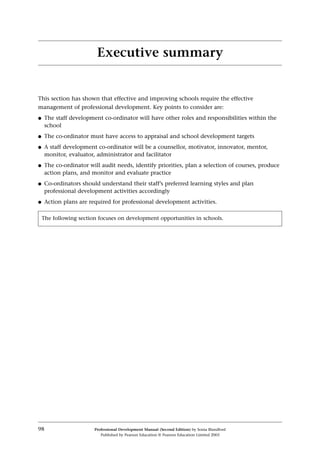































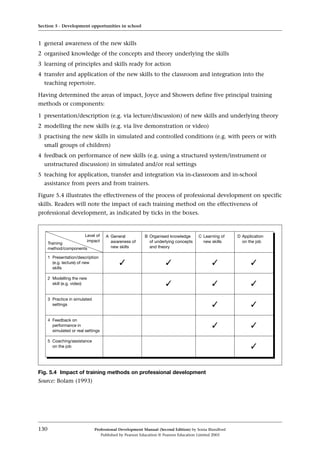

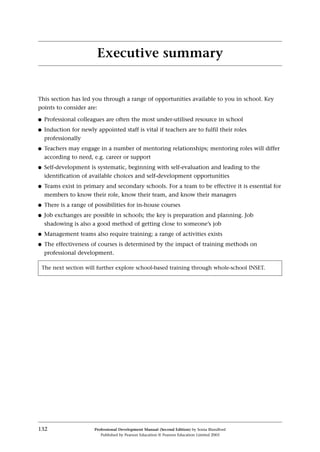




















![The following case study describes an INSET programme focusing on behaviour management.
INSET and performance management · 28
Professional Development Manual (Second Edition) by Sonia Blandford 153
Published by Pearson Education © Pearson Education Limited 2003
Demonstrating good practice
An example of good practice is a course that emanated from a collaborative approach to INSET
in a large suburban co-educational primary school and is also applicable to secondary schools.
Teachers had expressed concern over increasing problems with individual pupils and classroom
management. They felt that the existing discipline policy and procedures did not meet pupil
needs. As a consequence, teachers were highly stressed, and staff and pupil absenteeism was
prevalent. The headteacher, in consultation with LEA support agencies and his staff, devised a
course that focused on managing behaviour. The course programme was based on a series of
examples of good practice demonstrated on video, including:
q positive correction
q consequences
q prevention
q repair and rebuild.
The course ran during twilight sessions over a six-week period. The following statement
introduced the courses:
Behaviour management is an important area when considering raising expectations. Issues
about behaviour and discipline are in the frame each and every working day and new and
proven strategies are surely welcome to [all teachers].
Source: Priest (1997)
The value of this course was in its common-sense, jargon-free strategies of helping teachers
prepare for dealing with the situations that are likely to occur in the classroom:
q the child who refuses to leave the room
q the child who answers back
q the noisy classroom.
The examples were all the more convincing and absorbing because the presenter comes
across as a colleague, speaking from experience and explaining strategies that clearly work in
the classroom.
In the first of the examples, positive correction, the presenter states the painfully obvious
truth that most teachers under stress will correct a pupil from feelings of anger rather than in
a reasoned, calm and rational way. It is explained that behaviour management is an
emotional issue, but that there are more efficient and successful methods of correction than
resorting to intrusive and confrontational ways. Amongst the strategies discussed and
demonstrated in classroom settings are the following:
q tactical ignoring by teachers
q distraction and diversion
q cool-off time and rule reminders.
‘Take-up time’ is also defined; this gives a pupil enough time to do what the teacher asks
and enough time to allow both of them to save face.
Case study 28.1](https://image.slidesharecdn.com/34b749fb-5f3f-46c3-b666-27e993ce3bd1-150203125634-conversion-gate02/85/Professional-Development-Manual-170-320.jpg)





























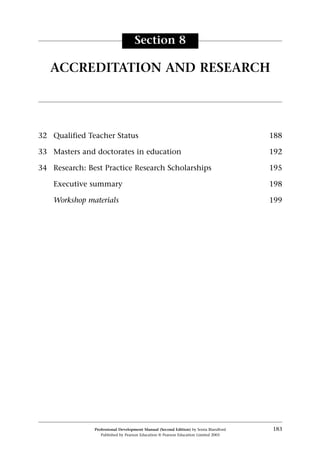













![GENERAL TEACHING COUNCIL AND HIGHER EDUCATION
The HEI sector represents a major resource for teaching and learning in schools. The
General Teaching Council (GTC) is working with institutions in the HEI sector to explore
how to make the most of their strategic contributions, including:
q making research-based evidence about teaching and learning, teacher development and
school improvement more accessible to policy makers and practitioners – this will
support innovations with the best available knowledge base, which includes conceptual
and theoretical understanding as well as empirical evidence
q providing extended support for developing capacity in schools – the relevant expertise
ranges from contributing to evaluation methods and instruments, to supporting
pedagogical experimentation and the management of change; the ESRC Teaching and
Learning Research Programme is seen as a crucial strategic partner.
The following illustrates the GTC’s level of engagement in teacher research initiatives:
Research: Best Practice Research Scholarships · 34
Professional Development Manual (Second Edition) by Sonia Blandford 197
Published by Pearson Education © Pearson Education Limited 2003
General Teaching Council – Research of the Month
Saunders (2002) reports that:
Research is a key strategic development area for the GTC. The council is committed to becoming an
evidence-based organisation in terms of its policy formation and advice to Government. Research of
the Month was evaluated after a pilot phase and is now an established feature of the GTC’s website.
Work (Research of the Month) is carried out by a team from CUREE – Centre for Using Research and
Evidence in Education, working in close conjunction with the GTC to select research that:
q Illustrates the complex tasks involved in teaching;
q Enables teachers to see clearly whether there are links with their own pupils and practice, and
what these are;
q Provides detailed information about the particular teaching and learning processes in classrooms
with which teachers can identify;
q [Is] written and presented as accessibly as possible, in case teachers want to obtain and read the
original text.
Further information is available on the website: www.gtce.org.uk/researchofthemonth
The National Teacher Research Panel
The National Teacher Research Panel was set up by the TTA in 1999 and in that short time
has accomplished a range of activities concerned with:
q promoting teaching as an evidence-informed activity
q emphasising the profession’s perspective in educational research.
The panel is now being hosted by a partnership between the DfES, GTC, National College for
School Leadership (NCSL) and TTA. The panel’s work will help the GTC to move forward on its
commitment to promoting teaching as an evidence-informed profession. The GTC is publicly
promoting the role and work of the panel at every opportunity, and within the GTC itself.](https://image.slidesharecdn.com/34b749fb-5f3f-46c3-b666-27e993ce3bd1-150203125634-conversion-gate02/85/Professional-Development-Manual-214-320.jpg)














